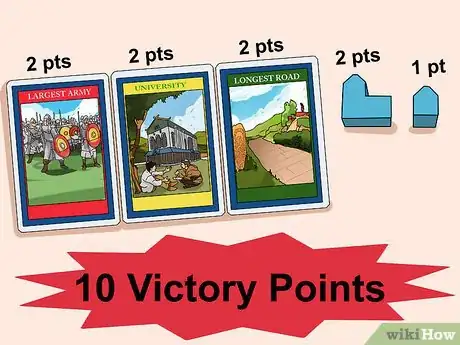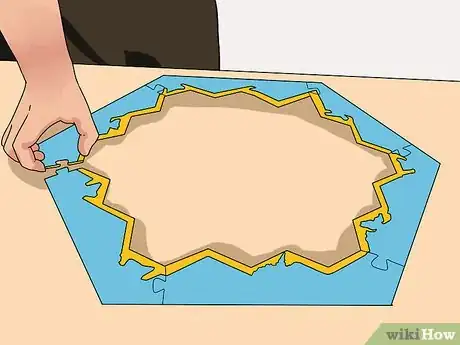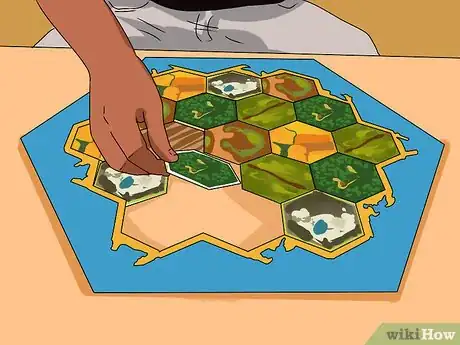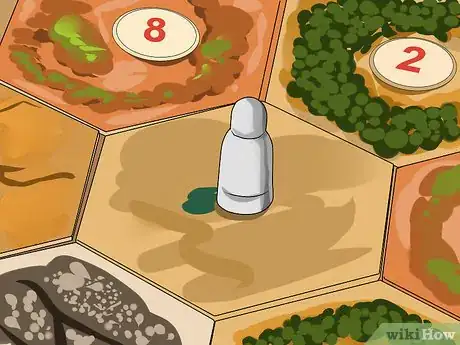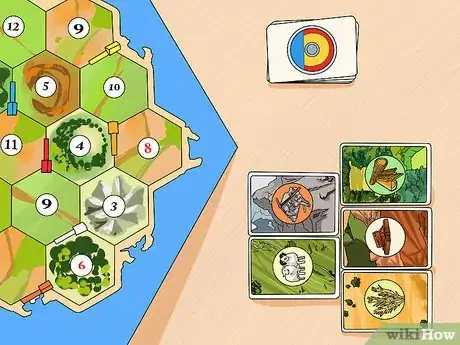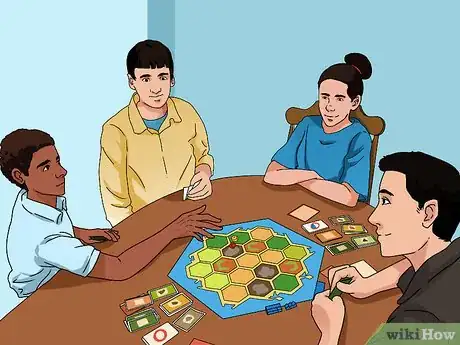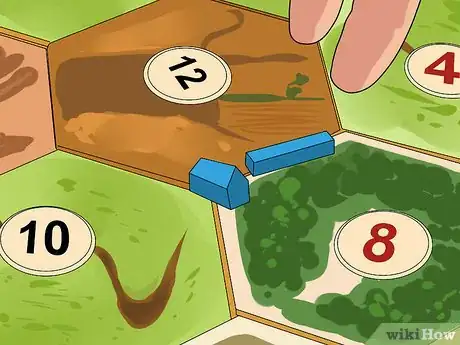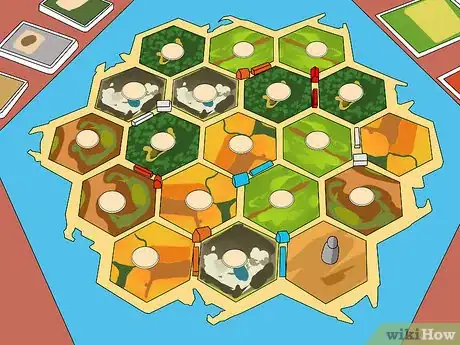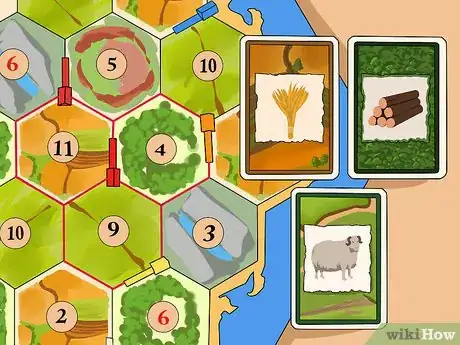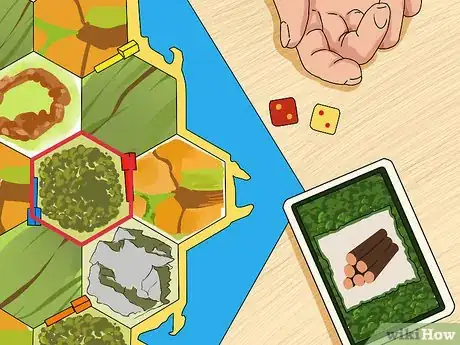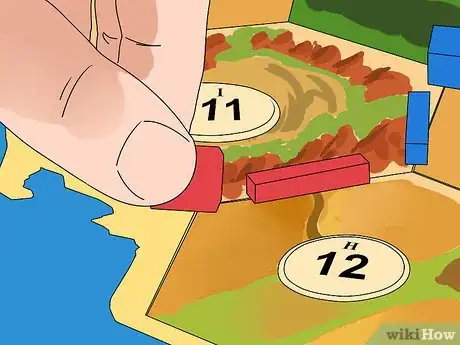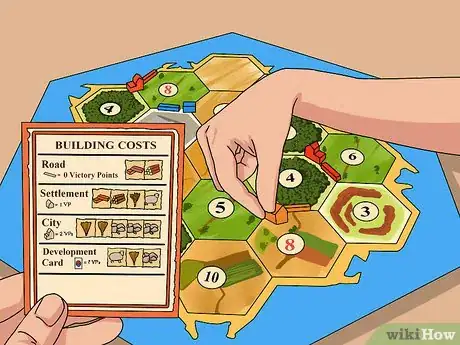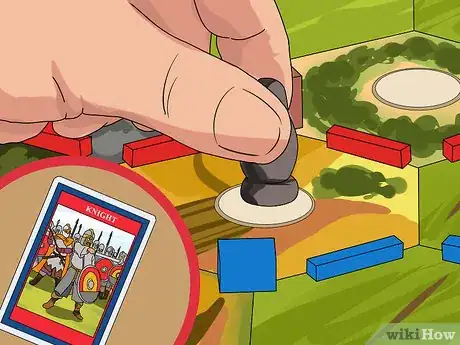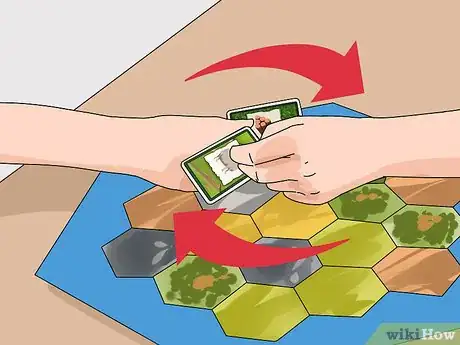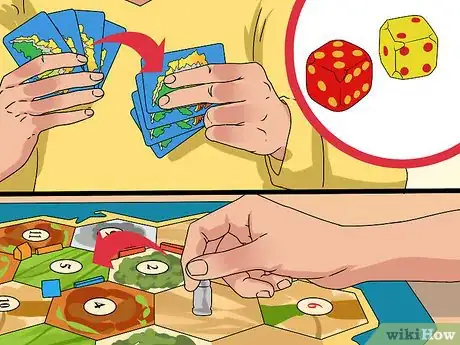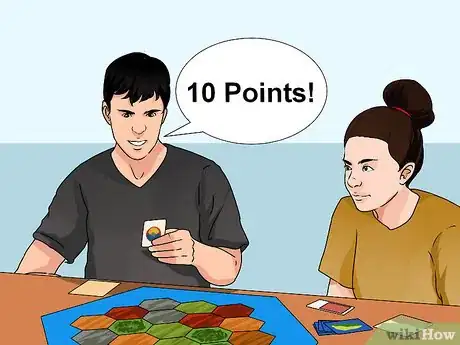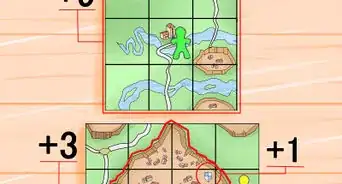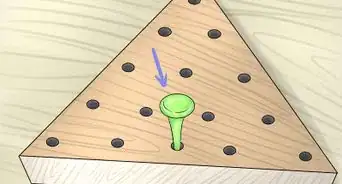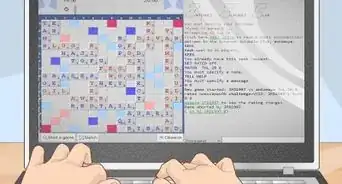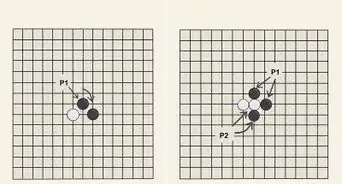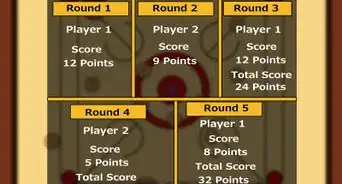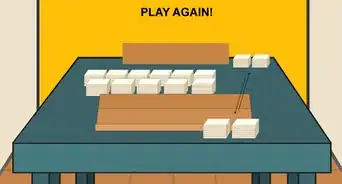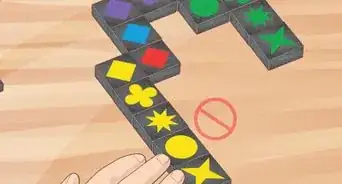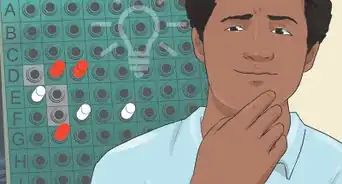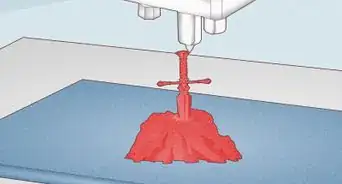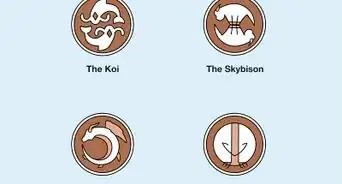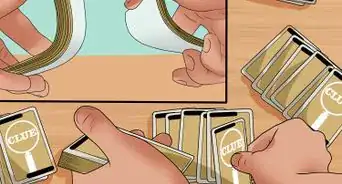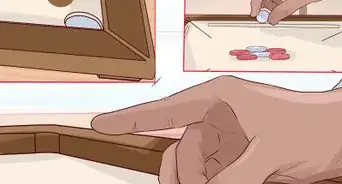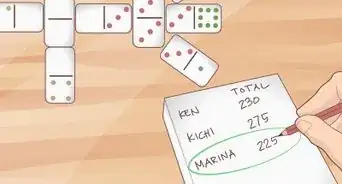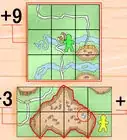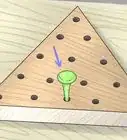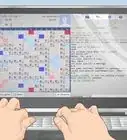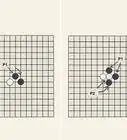wikiHow is a “wiki,” similar to Wikipedia, which means that many of our articles are co-written by multiple authors. To create this article, 18 people, some anonymous, worked to edit and improve it over time.
wikiHow marks an article as reader-approved once it receives enough positive feedback. In this case, several readers have written to tell us that this article was helpful to them, earning it our reader-approved status.
This article has been viewed 420,893 times.
Learn more...
The Settlers of Catan is a highly rated board game that has won several awards. Between 3-4 people can play the base edition, but a 5-6 player expansion is available if you want to play with more people. In Catan, the game board is always different, you can use multiple strategies to win, and there are lots of variations to the rules. Learn how to play Settlers of Catan and get some friends together for a game.
Steps
Setting Up the Game
-
1Check to see that you have all of the components of the game. Before you start setting up the game, check to see that you have everything. Doing so will also help you to become more familiar with the game pieces and parts.
- 19 terrain hexes (four sheep, four wheat, four wood, three brick, three ore, and one desert).
- Six sea frame pieces.
- 18 circular number tokens.
- A black/grey robber pawn.
- Four sets of wooden player pieces in four different colors each containing five settlements, four cities, and 15 roads.
- 25 development cards consisting of 14 knight/soldier cards, 6 progress cards, and 5 victory points.
- Resource cards of each terrain hex except for the desert.
- Four building costs cards, one for each player.
- "Longest Road" and "Largest Army" award cards.
- Two dice, one red, one yellow.
- Extra harbor pieces for placement of random harbors (optional).
-
2Understand the goal of the game. The object of Settlers of Catan is to be the first to gain 10 victory points. Points are earned by building structures, buying cards, and earning accomplishment cards such as “Longest Road” and “Largest Army”.[1]
- Each settlement is worth one victory point and each city is worth two victory points.
- Each "Victory Point" card is worth one victory point.
- Each special card is worth two victory points. The "Longest Road" card will be awarded to the first person to successfully build a continuous five roads. The card will switch hands whenever a player's number of connecting roads surpasses the longest continuous road of the cardholder. The "Largest Army" card will be awarded to the first person to play three "Knight" cards. The card will switch hands whenever a player plays more "Knight" cards than the "Largest Army" cardholder.
Advertisement -
3Make the outer frame. Before you lay down the hexes to create the game board, place the outer frame pieces. Each frame has a small number on the edges where it connects to other pieces. Put the frames together by matching the numbers up.[2]
-
4Place the hexes. Put a random terrain hex on the inside of the frame so that its edges are touching the sea frame. Keep putting down random terrains in a clockwise fashion until you have reached the center and all of the terrain hexes fill are inside the frame.[3]
- You may want to place the desert hex on an outside edge, away from any trade ports, to make the game a bit easier.
- A variation on this way of laying out the hexes is to place all of the hexes face down. They may only be turned upwards when someone places a road or a settlement on that hex.[4]
-
5Place the tokens. Each token has a small letter above its number. Place the number token with the letter "A" on one of the edge terrain hexes, put the token with the letter "B" to the right of the first placed token, and continue on putting down tokens in alphabetical order in a clockwise fashion until you have reached the center. All of the terrain hexes should now have a token on them. These numbers determine which roll will grant which player resources to use.[5]
- Do not place a number on the desert hex.
- You may also place tokens at random without paying attention to the letters, but this will make the game more challenging.
-
6Place the robber. Place the robber on the desert tile. The robber is the small gray piece that resembles a bowling pin. The robber starts out on the desert tile, but may be moved whenever someone rolls a seven or plays a Knight card.[6]
-
7Place the cards. The resource cards and development cards should be placed near the board where they are easily accessible to all players. Keep the resource cards separated by type (sheep, lumber, bricks, rocks, and wheat) and keep the development cards separate from the resource cards. Place the resource cards in five separate piles facing up and place the development cards in a separate pile facing down.[7]
- You should shuffle the development cards, but do not shuffle the resource cards!
Starting the Game
-
1Determine the turn order. Every player rolls two dice to start. The player who rolls the highest number gets to select his or her color and take the first turn. There are four colors included with the Base Catan 3-4 player set: red, blue, white, and orange.[8]
- After the player with the highest dice roll has chosen his or her color, have everyone else choose and then begin the turns.
- Turns progress in a clockwise manner.
-
2Place the first settlements. The first player places one of his settlements at an intersection, where three terrain hexes meet, the adjoining hexes are the resources he will earn if the number on that hex is rolled (so choose wisely!). Next, he places one of his roads on one of the three possible places next to his first settlement. The next player then takes her turn in the same way, but must place her settlement in a different area.[9]
- Roads must always be placed where two hexes meet and border the player's settlement.
- A settlement cannot be placed on an intersection adjacent to another intersection occupied by a settlement. There must be enough space for at least two roads between each settlement.
-
3Place the final settlements. The last player gets to place two settlements and two roads (one for each settlement) and then going counter-clockwise, the first players place their second settlement and second road until each player has two settlements and two roads down on the board.[10]
-
4Get your first resource cards. After all players have placed both of their settlements and roads, you all get some resource cards to start. Take one resource card for each hex tile that is adjacent to each of your two settlements.[11]
- For example, if one of your settlements is bordering a wheat, lumber, and sheep tile, then you get to take one wheat, one lumber and one sheep card. Do the same for your other settlement.
Taking a Turn
-
1Roll the dice. Each player's settlement will be touching three terrain hexes with three numbers. If the number that is rolled corresponds to the number that a player's settlement is on, then that player gets to pick up a resource card of that terrain hex. The same is true for a player with a city (instead of a settlement), except that they would get to pick up two resource cards.
- You also get more resource cards if you have more than one settlement bordering a hex. For example, if you have two settlements on the edges of a hex and that hex’s number is rolled, then you get two of that hex’s resource cards.
- All players are eligible to get resource cards even if they are not rolling the dice. If a number is rolled by another player and you have a settlement bordering that hex, then you get a resource card. The only exception is if the robber is on your hex. In that case, you are blocked from receiving any resources from that hex until someone moves the robber again.
-
2Take your turn actions. After the dice are rolled, the player then has the option of either building structures like roads or upgrading settlements to cities, playing a development card, or trading. Players may choose to do all or none of these actions. When a player has finished taking his or her actions, the player then passes the dice to the right.[12]
- You may only play one development card per turn.
-
3Build structures. During their turn, players can use resources that they have to build structures, such as roads, settlement, and cities. See your building cost card to figure out what you can build with the resources that you have. Keep in mind that each settlement is worth 1 point and each city is worth 2 points, but you have to upgrade settlements to cities. You cannot just build a city without first having a settlement.[13]
- To build a road you need: One wood and one brick
- To build a settlement you need: One wood, one brick, one sheep, and one wheat
- To build a city you need: Three ore and two wheat. Cities can only be built in place of an already existing settlement.
- To buy a development card you need: One sheep, one wheat, and one ore
-
4Play a development card. Players may play development cards at the beginning or end of their turn. Development cards do different things but their effects are clearly stated on the card itself. Development cards come in the following types:[14]
- A "Knight" card allows a player to move the robber to any spot on the board and then gets to take a card from any player that has a settlement or city on the blocked resource.
- A "Road Building" card allows a player to place two roads on the board.
- A "Year of Plenty" card gives a player any two resource cards.
- After a player plays the "Monopoly" card, that player announces one type of resource. Every player must then give that player all of that type of resource card(s) in their hand.
- A "Victory Point" card automatically gives the player one victory point.
-
5Pay attention to the instructions on development cards because each card type has a different function. For example, if you play a knight card, you must turn it face up and move the robber right away. You may move the robber to any hex and then collect one resource (at random) from the opponent who owns that hex. If two opponents have settlements bordering that hex, then you may choose who to rob.[15]
- Keep any victory point cards that you draw face down so that your opponents cannot see them.
-
6Trade as needed. The player can also trade for resources, either with any other players or with the bank. A player may trade in four of the same resource card for any resource card. If player is on a special harbor, that player may trade in two of that harbor's resource for any resource card. At a generic harbor a player may trade in three of the same resource card for any resource card.[16]
-
7Watch out for sevens. If a player rolls a seven, then each player must make sure that he/she does not have more than seven cards in his or her hand. If a player does have more than seven cards, that player must discard half of them. The person that rolled the seven then gets to put the robber on whatever number token he/she desires, and then, gets to take one card from any player that has a settlement or city touching the terrain hex with the robber on it.[17]
- Keep in mind that the robber blocks players from getting resource from a hex. In other words, if the hex number occupied by the robber is rolled, players with settlements or cities on that number do not get to collect the resource the robber is blocking.
-
8Use strategy to increase your chances of winning. There are a number of strategies that you can use to help you get the upper hand and win the game. The most basic strategy is to get your starting settlement in an area that give you access to the most commonly rolled resources (the resources with the red or physically larger numbers). Some other strategies include:
- Setting yourself up to build roads and settlements by aiming for lots of brick and wood hexes in the beginning.
- Monopolizing ports. Try to get a port and at least two cities on different hexes with the same resource, so that you can trade for whatever you need.
- Targeting the winning player(s) with the robber and Knight cards. Robbing your opponents can keep them from progressing too much while also gaining yourself some extra resources.
- Building cities (and settlements) as soon as you can. When you have lots of resources to work with, you'll be able to trade and build easily.
-
9Announce when you have 10 victory points. To win the game, you need to be the first one to get 10 victory points. Once you achieve this number, announce it to your fellow players. Keep in mind that your victory points cards and any special cards, such as “Longest Road” or “Largest Army”, will count towards your 10 point total. Keep a running total of your points as you play the game so that you don’t surpass 10 points without noticing.[18]
- You can extend the game by playing until someone achieves a higher number of points, like 12 or 14 points.
Community Q&A
-
QuestionWe had a situation where a player had 8 points on the board and two victory point cards. Can she use both to make her 10 points?
 Community AnswerYes, she can. Victory point cards are the only development cards that more than one can be played on each turn.
Community AnswerYes, she can. Victory point cards are the only development cards that more than one can be played on each turn. -
QuestionIf it states that if a player has more than seven cards, he/she discards half, does that mean the player needs to have eight cards - or is it seven or more cards?
 Community AnswerYou need to have eight cards to have to discard half. You are safe if you have seven.
Community AnswerYou need to have eight cards to have to discard half. You are safe if you have seven. -
QuestionCan you buy a settlement before buying a road?
 Community AnswerYou need to have roads in between any settlements in the game, so it depends on the situation. In the beginning of the game, you will need to place another road right next to one of your starting roads to be able to build the settlement, or you can use the road building development card to build roads.
Community AnswerYou need to have roads in between any settlements in the game, so it depends on the situation. In the beginning of the game, you will need to place another road right next to one of your starting roads to be able to build the settlement, or you can use the road building development card to build roads.
References
- ↑ http://unicornsrest.org/reference/catan/mf_rules.htm
- ↑ http://unicornsrest.org/reference/catan/mf_rules.htm
- ↑ http://unicornsrest.org/reference/catan/mf_rules.htm
- ↑ http://www.cheatography.com/davechild/cheat-sheets/settlers-of-catan/
- ↑ http://unicornsrest.org/reference/catan/mf_rules.htm
- ↑ http://unicornsrest.org/reference/catan/mf_rules.htm
- ↑ http://unicornsrest.org/reference/catan/mf_rules.htm
- ↑ http://unicornsrest.org/reference/catan/mf_rules.htm
- ↑ http://unicornsrest.org/reference/catan/mf_rules.htm
- ↑ http://unicornsrest.org/reference/catan/mf_rules.htm
- ↑ http://unicornsrest.org/reference/catan/mf_rules.htm
- ↑ http://boardgamegeek.com/boardgame/13/catan
- ↑ http://unicornsrest.org/reference/catan/mf_rules.htm
- ↑ http://unicornsrest.org/reference/catan/mf_rules.htm
- ↑ http://unicornsrest.org/reference/catan/mf_rules.htm
- ↑ http://unicornsrest.org/reference/catan/mf_rules.htm
- ↑ http://unicornsrest.org/reference/catan/mf_rules.htm
- ↑ http://unicornsrest.org/reference/catan/mf_rules.htm
About This Article
Settlers of Catan is a 3-4 player board game where players try to collect resources and build a civilization to earn victory points. The first player to earn 10 victory points wins the game. Players get 1 victory point for each settlement they build, 2 victory points for each city they build, 2 victory points if they build the longest road, and 2 victory points for assembling the biggest army. There are also development cards that can give players victory points. To set up the game, first shuffle the hexagonal terrain pieces face down. Then, randomly flip them over and make them into a hexagon made of 19 terrain pieces. There are 5 terrain types in Catan, including hills, forest, mountains, fields, pasture, and desert. Next, place the numbered water cards around the outside of the hexagon by placing 1 water hexagon against every other terrain with the numbered side facing in towards the center. Fill in the blank spaces between the numbered water cards with the blank water cards. Now, randomly place the numbered tokens on the terrain spaces, skipping the desert and water spaces. Place the robber token on the desert. The terrain spaces produce resources and provide cards that you collect to help you build. The hills make brick, forest makes lumber, mountains make ore, fields make grain, pasture makes wool, and desert doesn’t produce anything. Separate these resource cards into separate piles and set them face-up next to the board. Shuffle the development cards and place them face-down next to the resource cards. Every player picks a color to play and takes the road, settlement, and city pieces for their color. Each player rolls the dice and the player who rolls the highest number goes first. Play moves clockwise around the table. On the first turn, players set 1 settlement at any intersection where 3 terrain hexes meet, and 1 road on an adjacent line leading away from their settlement. Players may not place their first settlement on a junction that is adjacent to another player’s settlement. Then, going in reverse order, players place an additional settlement and road. Next, each player receives 1 resource card for each terrain that their second settlement borders. For example, if a player’s second settlement is at the junction where a mountain hex meets two forest hexes, they would take 1 ore card and 2 lumber cards. Now the player that placed the first settlement goes first. To start a turn, the active player rolls two dice. The combined number on the dice determines which terrain hexes produce resources for that turn. For example, if a player rolls a 6, every hex with a token that says “6” on it makes its resource. Any player that has a settlement in an adjacent junction gets 1 resource card for that numbered hex. If you have a city in the junction, you get 2 resource cards. There are no hand size limits, but if any player rolls a 7, the players with more than 7 resource cards discard half of their resource cards. Also, when a 7 is rolled, the player that rolled it gets to move the robber token to any hex on the board. The robber covers the numbered hex and that terrain produces no resources for as long as the robber stays there, even if the numbered token is rolled on the dice. If there is a settlement or city on a junction where the robber is moved, the player that moved the robber chooses 1 card at random from the owner’s hand and steals it. After the dice have been rolled and resource cards have been distributed, the active player can trade resources with other players, trade with the bank, or buy something. They can do any combination of these things on their turn. Any player trades are legal so long as both players agree, however, players cannot trade development cards. To trade with the bank, players must exchange 4 identical resource cards for 1 card of any type. If a player controls a settlement on a port junction, which is a port on a corner of a numbered water hex, they can use the ratio listed on that water hex to exchange resources with the bank instead. For example, if the player has a settlement or city on the corner of the water hex that says 3:1, they can trade 3 resource cards instead of 4 to get another card from the bank. If there is a specific resource symbol on the port, that ratio only applies to trades for the matching resource. Players can also buy something on their turn. To buy a road, settlement, or development card, players follow the key on the “Building Costs” card to pay the bank for their piece. For example, a player can pay 1 brick and 1 lumber to build a road. When a player buys a piece, they place it on the board immediately. Roads must be placed on a line between hexes and must connect to another road, settlement, or city the player owns. Players can only build 1 road on each line. If they have the longest road in the game and it is at least 6 pieces long, they get the “Longest Road” card, which is worth 2 victory points. If someone else builds a longer road over the course of the game, they get that card. To build a settlement, a player must place it on an intersection between hexes that is connected by at least 1 road. They may not place a settlement on any junction where there is an existing settlement, and each adjacent junction must be empty for the player to place a settlement there. Players can only place cities by upgrading settlements. If they build a development card, they can play it on their next turn. Players can only play 1 development card per turn. Each card has instructions on it, but one of the most common and important cards is the knight. The knight allows players to move the robber to any terrain hex and steal a resource card of their choosing from the owner of an adjacent settlement or city. When a player plays a knight, they place it face up in front of them and leave it there. It stays in place for the remainder of the game. If a player has more than 3 knights in front of them at any point in the game and they have the highest number of knights, they get the “Largest Army” card. This card is worth 2 victory points. Play continues until 1 player gets 10 victory points and wins! Keep reading to learn strategies for keeping your opponents from earning victory points!

